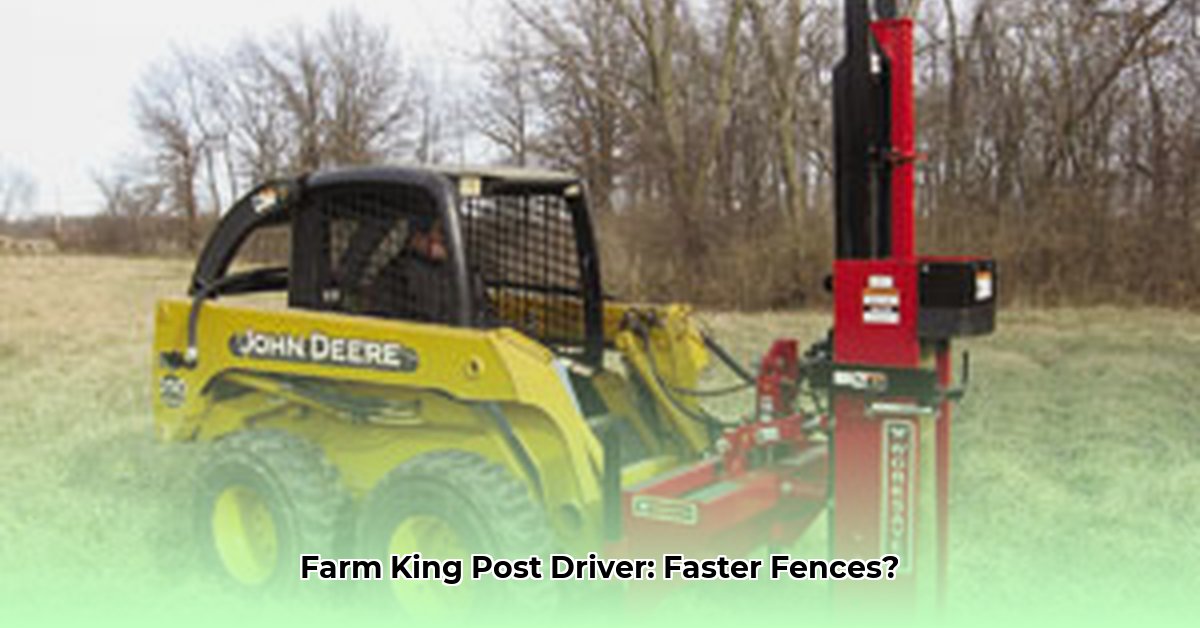
Building and maintaining strong fences is crucial for successful farming. A reliable tractor-powered post driver significantly increases efficiency. Farm King offers two popular models—the 1450 and the 2400—each with its own strengths and weaknesses. This guide provides a comparative analysis to help you choose the best model for your farm.
Tractor Fence Post Driver: Choosing Between Farm King 1450 and 2400
This detailed comparison will guide you towards selecting the most appropriate Farm King post driver for your unique farming operation and needs. We’ll examine key features, operational considerations, and sustainability impacts to empower informed decision-making.
Farm King 1450 vs. 2400: A Detailed Comparison
Choosing the right post driver is critical for efficient fence construction. This table highlights key differences between the Farm King 1450 and 2400 models, helping you match equipment to your farm’s specific requirements.
| Feature | Farm King 1450 | Farm King 2400 | Implications |
|---|---|---|---|
| Mounting System | Three-point hitch (attaches directly to tractor); also compatible with some skid steers | Trailer-mounted (requires a tractor to pull) | The 1450 offers simpler setup for farmers already utilizing three-point hitch implements. The 2400 is more versatile for relocation. |
| Power Source | Tractor Hydraulics | PTO-driven (Power Take-Off) or Engine-driven | The 1450 relies on your tractor's hydraulic system. The 2400 offers flexibility, choosing between tractor power or a dedicated engine. |
| Weight | Lighter, improved maneuverability | Heavier, enhanced stability on uneven terrain | Lighter weight improves ease of transport and maneuverability in tight spaces. Heavier weight offers greater stability on uneven ground. |
| Impact Power | 100,000 lbs of impact force | 100,000 lbs of impact force | Both deliver substantial impact force, effectively driving posts into the ground. The crucial differences lie in other specifications. |
| Cost | Lower initial investment | Higher initial investment | The 1450 offers a lower upfront cost. The 2400 represents a larger initial investment, potentially offset by increased efficiency. |
| Maneuverability | Excellent maneuverability in smaller fields | Maneuverability adaptable to various terrains | The 1450 is ideal for smaller, flatter fields. The 2400's trailer-mounted design allows for maneuverability across diverse terrains. |
Choosing Your Farm King Post Driver: A Step-by-Step Guide
Making the right decision requires careful consideration of your individual needs. This step-by-step guide will help you navigate the process:
Budget Assessment: Determine your budget. The 2400's higher cost might be justified by increased efficiency for large-scale operations. For smaller farms, the 1450 offers excellent value.
Farm Size and Terrain Evaluation: Larger farms with varied terrain may benefit from the 2400's versatility and greater power. Smaller, flatter farms might find the 1450 perfectly adequate. What is the size of your farm, and how diverse is its terrain?
Equipment Compatibility: Ensure your tractor can handle the chosen model's power requirements and mounting system. Does your tractor have the necessary hydraulics (1450) or PTO capabilities (2400)?
Soil Analysis: Hard or rocky soils might necessitate the additional power options of the 2400 engine-driven model. Softer soils present less of a challenge to either model. What type of soil predominates on your farm?
Projected Usage: Estimate your frequency of use. Infrequent use may justify the cost savings of the 1450. Frequent use might favor the efficiency of the 2400. How often will you need to utilize the post driver?
Operating and Maintaining Your Farm King Post Driver for Optimal Performance
Proper operation and routine maintenance are critical for optimal performance, safety, and equipment longevity.
Pre-Operation Checks: Always check hydraulic fluid levels (1450) or engine oil levels (2400), inspect the post guides, and confirm all safety mechanisms are functioning correctly before each use.
Safe Operating Procedures: Maintain a steady pace when driving posts to avoid damage. Consistent pressure ensures optimal penetration, especially in challenging soils.
Routine Maintenance: Regular lubrication is vital. Refer to the manufacturer's maintenance schedule for specific recommendations. Addressing any maintenance needs promptly extends the equipment's lifespan. Have you set up a maintenance schedule?
Sustainability and Environmental Impact: A Long-Term Perspective
Both models contribute to sustainable farming by improving fencing efficiency. However, fuel consumption might differ. The 2400 (especially the engine-driven version) might have a higher fuel consumption rate than the 1450, potentially impacting your carbon footprint. A comprehensive Life Cycle Assessment (LCA) would provide detailed environmental comparisons. Exploring options such as biodegradable hydraulic fluids for the 1450 would further enhance sustainability.
Conclusion: Selecting the Ideal Post Driver for Your Farm
Choosing between the Farm King 1450 and 2400 depends on your specific farming operations and needs. This detailed analysis provides the information necessary for informed decision-making, enabling you to select the model that best maximizes efficiency, promotes sustainability, and aligns with your budget and long-term goals. Remember that technological advancements might influence future choices; staying updated is always beneficial.